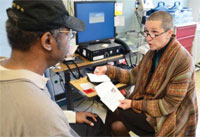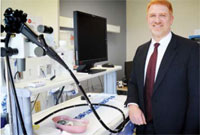Office of Research & Development |
 |



Veterans at 42 VA medical centers will take part in a major new study to find out which screening method works best to curb mortality from colorectal cancer.
Colorectal cancer is the third most common cancer in the U.S. It is also the second leading cause of cancer deaths, behind lung cancer. VA diagnoses some 4,000 new cases of the disease each year in Veterans.
The ambitious study will be the largest VA Cooperative Studies Program effort to date, aside from the ongoing Million Veteran Program. The trial will enroll up to 50,000 Veterans over the next two to three years and follow them for a decade to track deaths, cases of colon cancer, and other outcomes.
Researchers will compare two screening methods. One is colonoscopy, considered the "gold standard" for early detection of the disease. In the procedure, doctors insert a long, thin, flexible tube to view the entire colon, and any precancerous growths—known as polyps—can be snipped out right on the spot. But the procedure is invasive and costly, and occasionally causes complications, such as a tear in the intestines.
The other method is fecal occult blood testing (FOBT), a simple test in which a small plastic device is used to sample feces, which is then checked in the lab for signs of hidden blood. The study will use a relatively new form known as fecal immunochemical testing (FIT). The test has its pluses, but the extent of its effectiveness in reducing mortality is unclear.
Most screening guidelines—including VA's—recommend either FOBT every year or colonoscopy every 10 years, and it is those two approaches the new study will compare. A third option some patients choose is sigmoidoscopy (which examines just part of the colon) every five years, along with FOBT every three years.
VA Research Currents spoke with the leaders of the study, known by the acronym CONFIRM (for Colonoscopy versus Fecal Immunochemical Testing in Reducing Mortality from Colorectal Cancer.) Co-chairs are Jason Dominitz, MD, MHS, of the Seattle VA Medical Center, and Douglas Robertson, MD, MPH, of the White River Junction VA. Dominitz is also VA's national program director for gastroenterology.
Research Currents: Why is there a need to do this trial?
JD:
Until recently, it was just assumed, without objective evidence, that colonoscopy had to be better than less invasive tests, such as sigmoidoscopy or FIT
testing. However, because of some of the recent data, those assumptions are being reconsidered. Only a prospective trial can definitively answer the
question of whether this invasive test is superior to less invasive alternatives at detecting and reducing mortality from colorectal cancer. Fortunately,
VA has mechanisms to embark on this type of large-scale, comparative effectiveness research.
Other methods of CRC screening, besides those mentioned above, are in development. Here's a look at some of them, with a rundown of the pros and cons, according to VA clinician-researchers Drs. Jason Dominitz and Douglas Robertson.
RC: How is it that colonoscopy, which offers the most comprehensive check of the colon, may not be the best screening measure to prevent
cancer deaths?
JD:
There are two areas of concern. First, recent studies suggest that interval cancers—tumors that develop after a colonoscopy that found no cancer—are more
common than previously thought. The guidelines call for most adults 50 and older to get a colonoscopy only every 10 years if no polyps are found, so the
ability to catch interval cancers is limited.
The second area of concern has to do with the location of these interval cancers in the colon. Research suggests colonoscopy may be better at preventing cancer on the left side of the colon [the half closest to the rectum] than on the right side. If there is no benefit of colonoscopy on the right side of the colon, it raises the question of what additional benefit is offered by the extra invasiveness, risk, and expense of colonoscopy compared to sigmoidoscopy. Colonoscopy evaluates the entire colon, while sigmoidoscopy examines only the left side of the colon.
Some recent studies have found that colonoscopy is associated with a reduced risk of cancer on the right side of the colon, but not to the same extent as with the left side. So the findings are mixed. We expect our study to provide more definitive data on the overall effectiveness of colonoscopy.
RC: What is fecal immunochemical testing? Why is it better than older methods of fecal occult blood testing?
DR:
The main advantage of FIT is that it is specific for finding human hemoglobin in stool. Older types of FOBT look for evidence of any blood in the stool,
not specifically human hemoglobin. So the test could give a false positive result if the person ingested some blood in his food—say, from red meat. Even
orange juice can sometimes cause false negative results. The FIT is not impacted by diet. FIT testing can also be performed in a quantitative fashion. This
lets you measure the amount of blood in the stool. As a result, you can make it more or less sensitive or specific based on the threshold of
hemoglobin you look for in the stool. [A test that is more sensitive will pick up more things but may yield more false positives, leading to unnecessary
follow-up testing. A test that is more specific will be more selective in what it detects but may miss some problems.]
The FIT assay can also be automated, which reduces the chance for human error in interpretation of the test results. Another advantage is that it can be implemented as a single-sample test, whereas FOBTs generally require three samples from the patient. Studies have shown that people are more likely to complete the FIT test than the traditional FOBT.
RC: What about virtual colonoscopy, an imaging technique that allows doctors to view the colon without inserting a tube? Why aren't you comparing that
method as well?
DR:
Virtual colonoscopy, also known as CT colonography, is recommended by one of the major guidelines as a screening tool and continues to be developed for
this application. The prospect of being able to use this test without a colon prep [namely, taking laxatives to clean out the bowel] is important because
it may entice some to get screened who might not otherwise. That said, it is important to remember that screening is generally performed on symptom-free,
healthy people, and while the radiation exposure of virtual colonoscopy is low, it is not zero. Therefore from a risk-benefit standpoint, there is some
concern about exposing patients to radiation to screen their colon when other good noninvasive tests (without radiation exposure) are an option.
Another concern that may ultimately limit its applicability is that it frequently will detect polyps that will require colonoscopy anyway. This is particularly an issue in VA, where polyp rates tend to be higher than in the general population. Finally, the test may detect lesions outside the colon—such as in the kidney—that may or may not be significant. In some cases, where those lesions are actually not important, the patient may end up undergoing unnecessary follow-up testing.
RC: By the time the study is completed, in 2025, isn't it likely there'll be new ways of catching colorectal cancer early on, besides the two methods
being tested?
JD:
No matter what other noninvasive test is developed, the definitive test is likely to remain colonoscopy. In other words, all non-colonoscopy screening
tests that are positive should be followed-up with a colonoscopy—that's the case now, and it's likely to stay that way into the future. So understanding
how the test works is going to be critically important no matter what else happens in the next 10 or 20 years. Of course, we will learn a great deal of
other important information from this study. We will examine the complication rates of colonoscopy and factors that predict or are associated with the
occurrence of interval cancers, to name a few. As of now, the medical community lacks high-quality, prospective evidence of the effectiveness of
colonoscopy. That is what we hope to gain from this trial.